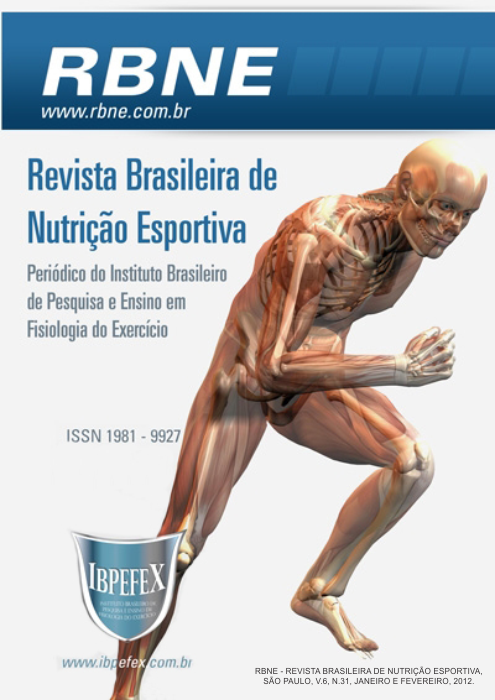Quinoa: a vegetable protein supplement for practitioners of physical activity
Abstract
Introduction: The incorporatingofhealthy eating habits is a major concern worldwide. It is known that, to be healthy, one must consider not only the feeding of an individual, but also other habits such as regular practice of physical activities. However, some eating precautions must be taken into consideration so that health is not impaired. The inclusion of certain cereals as a food supplement is a viable strategy to avoid any lack of nutrients such as essential amino acids. The quinoa, for example, is a cereal composed of proteins that may benefit health and sports. Objective: The objective of this study is analyze the amino acid profile of quinoa and check the possibility of being consumed by individuals engaged in physical activities. Literature review: In assessing the nutritional composition of quinoa, we could verify that it is a food that includes all the essential amino acids, with no limitingamino acids such as lysine and tryptophan, unlike other cereals. In addition, it is highly digestible in comparison to other vegetable and animal food. Conclusion: Quinoa is a food that can promote health and athletic performance of individuals due to itscontent of amino acids and its high bioavailability. It is recommended the realization of practical studies with the cereal to sportsmen for better evaluation of its nutritional benefits.
References
-Alves, L. F.; Rocha, M. S.; Gomes, C. C. F. Avaliação da Qualidade Protéica da Quinua Real (Chenopodium Quinoa Wild) Através de Métodos Biológicos. E-scientia. Belo Horizonte. Vol. 1. Num. 1. 2008.
-Blomstrand, E.; Eliasson, J.; Karlsson, H. K. R.; Köhnke, R. Branched-Chain Amino Acids Activate Key Enzymes in Protein Synthesis After Physical Exercise. Journal of Nutrition. Vol. 136. 2006. p. 269-273.
-Borges, J. T.; Bonomo, R. C.; Paula, C. D.; Oliveira, L. C.; Cesário, M. C. Características Físico-Químicas, Nutricionais e Formas de Consumo da Quinoa (Chenopodium Quinoa Willd.). Temas agrários. Colômbia. Vol. 15, Num. 1. 2010. p. 9-23.
-Campbell, B.; Kreider, R. B.; Ziegenfuss, T.; Bounty, P.; Roberts, M.; Burker, D.; Landis, J.; Lopes, H.; Antonio, J. International Society of Sports Nutrition Position Stand: Protein and Exercise. Journal of the International Society of Sports Nutrition. London. Vol. 4. Num. 8. 2007. p. 1-7.
-Elango, R.; Ball, R. O.; Pencharz, P. B. Amino Acid Requirements in Humans: With a Special Emphasis on the Metabolic Availability of Amino Acids. Amino Acids. Vol. 37. 2009. p. 19-27.
-Kopman, R.; Saris, W. H. M.; Wagenmakers, A. J.M.; Loon, L. J. C. Nutritional Interventions to Promote Post-Exercise Muscle Protein Synthesis. Sports Med. Vol. 37. Num. 10. 2007. p. 895-906.
-Paschoal, V.; Marques, N.; Brimberg, P.; Diniz, S. Suplementação Funcional Magistral dos Nutrientes aos Compostos Bioativos. São Paulo. Medfarma. 2009. p. 399-406.
-Tipton, K. D. Symposium 2: Exercise and Protein Nutrition. Efficacy and Consequences of Very-High-Protein Diets for Athletes and Exercisers. Proceedings of the Nutrition Society. 2001. p. 1-10.
-Williams, M. Dietary Supplements and Sports Performance: Amino Acids. Journal of the International Society of Sports Nutrition. London. Vol. 2. Num. 2. 2005. p. 63-67.
-Wu, G. Amino Acids: Metabolism, Functions, and Nutrition. Amino Acids. Vol. 37. 2009. p. 1-17.
Authors who publish in this journal agree to the following terms:
- Authors retain the copyright and grant the journal the right of first publication, with work simultaneously licensed under the Creative Commons Attribution License BY-NC which allows the sharing of the work with acknowledgment of the authorship of the work and initial publication in this journal.
- Authors are authorized to enter into additional contracts separately for non-exclusive distribution of the version of the work published in this journal (eg, publishing in institutional repository or book chapter), with acknowledgment of authorship and initial publication in this journal.
- Authors are allowed and encouraged to post and distribute their work online (eg, in institutional repositories or on their personal page) at any point before or during the editorial process, as this can bring about productive change as well as increase impact and impact. citation of published work (See The Effect of Free Access).






